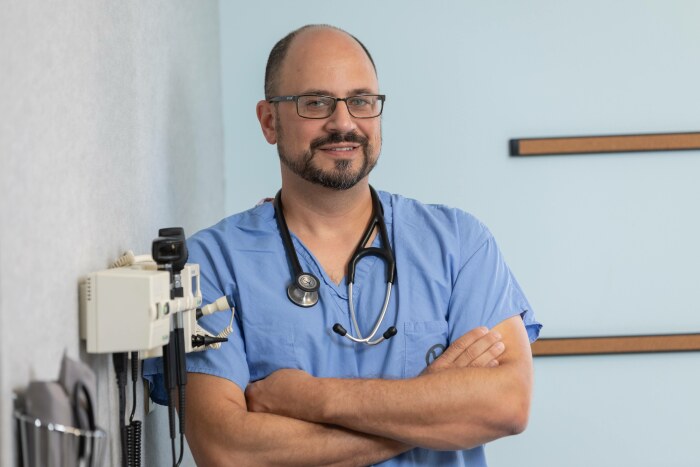Glenn Hurst is a family physician in southwest Iowa and a Democratic candidate for U.S. Senate.
Several years ago, a man called my clinic seeking an appointment. He did not have insurance, and in fact had not seen a physician since childhood. But on this day, he was desperate. He had felt a popping sensation in his abdomen and thought he might have a hernia. If that was true, he needed surgery, and we were the gateway to that service. We agreed to see him and to work out a payment plan later.
When I entered the exam room, it was clear something was wrong. Here was a man in his late 50s who did not look well. His skin had a bronze-yellow tint, his cheeks were sunken in, and his belly protruded. He was weak and disheveled. He repeated his story about the popping sensation and told me he could feel something protruding.
I had him lay back on the exam table and I performed a routine exam. When I felt the right side of his belly, I felt something strange. It was like running my fingers over marbles under his skin. This is where he had felt the pop.
I sent him for an ultrasound which confirmed my suspicion. He had cancer in his liver. He was referred immediately to Oncology where it was discovered that he had stage 4 colon cancer with metastasis to the liver. He had less than a 5 percent chance of survival and chose to go on hospice. He died less than 6 months later.
He died from a condition that could have been prevented if he had had colon cancer screening at the appropriate time. It is one of the essential benefits covered by Insurance policies since the Affordable Care Act, but he had no insurance. I often wonder if his case would have been different if he did have coverage. I have many patients who have not had cancer screenings, or immunizations, or aneurysm screens because these services are not easily accessible even though they have private insurance.
Service industries and health care often sit near the top of the list of a rural county’s largest employers. But these services are dwindling in number. 13 Nursing homes closed in Iowa between 2015-2019. (Flinn, 2020) The percentage of those that were in rural areas was 62 percent. (Flinn, 2020) According to studies of the viability of hospitals across America, a staggering 40 rural Iowa hospitals, 44 percent of all Iowa hospitals, are at high risk of closing. (Ellison, 2021)
Because services are not readily available, the people in Iowa’s rural counties and communities are in desperate straits. The absence of health care services leads to a loss of population that then leads to reduced services and a vicious cycle of failing communities is perpetuated.
According to the 2020 U.S. Census, 68 Iowa counties lost population. (Webber, 2021) They have been holding on by mere threads in many cases for the last 40 years. Many rural counties have lost roughly 25 percent of their population since 1980 (Iowa State University Iowa Community Indicators Program, 2010) With the report of the recent U.S. Census, some communities face what seems to be the inevitable abyss.
A health care plan that provides coverage to all 331 million Americans provides a launching pad for the recovery of the industry, and for all rural Iowa. The infusion of health care providers, money, and services into rural Iowa will finance and drive the new American infrastructure: childcare, reliable broadband, new home construction, and transportation services.
A Medicare for All system would extend care to almost 85 million people in America who are uninsured or underinsured. These additional covered lives will require the system to grow. Fostering this growth in rural communities means expanding services in our brick-and-mortar facilities. More hospital wards, nursing home beds, and clinic visits will require an educated, well-paid workforce. It will make clinics that currently struggle to keep the doors open, viable. Local pharmacies and therapy groups will service more individuals and their once struggling rural markets will now attract their presence.
A Medicare for All system is an opportunity for rural Iowa to adapt and survive. It makes rural living a viable option for young families looking for a place to put down their roots. It protects the lives of those in our communities who suffer from chronic illness. It creates opportunities for our seniors to live out their golden years in the communities they built. It provides opportunities for both individuals and communities to thrive.
Bibliography
Ellison, A. (2021, January 2). State-by-state breakdown of 897 hospitals at risk of closing.
Flinn, B. (2020, February). Nursing Home Closures and Trends, June 2015 – June 2019.
Iowa Department of Natural Resources. (2021). 2020 Integrated Report and Impaired Waters List: Submitted to US EPA on February 17, 2021. ADBnet.
Iowa State University Iowa Community Indicators Program. (2010). 2010 Census. Ames, Iowa.
McCarthy, N. (2019, August 8). How U.S. Healthcare Spending Per Capita Compares With Other Countries [Infographic]. Forbes.
Webber, T. (2021, August 13). Use this interactive map to see what the 2020 census data says about your Iowa neighborhood. Des Moines Register. Des Moines, Iowa, USA.


1 Comment
Women’s March Woman2Woman Circle support Dr. Hurst
Dr. Hurst continues to commit to issues that are important to Iowans especially rural Iowans. Using his knowledge, his experience and facts, Dr. Hurst is showing how Iowa can thrive not just survive with a Medicare for All system. We must have the medical services needed without driving to the larger cities. A sure sign of future ghost town squares is to lose accessibility to medical care.
We need a true leader such as Dr. Hurst to fight for Medical Equality.
Your friend in service, Susan Mrzena
Susanmrzena Mon 3 Jan 11:06 PM